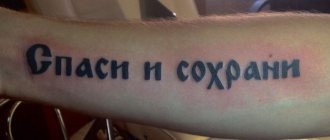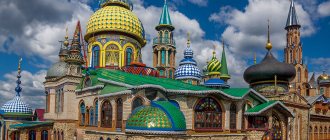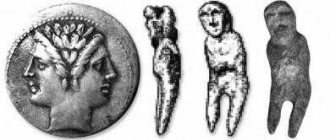- Tattoos in different religions
- Catholicism
- Christianity
- Islam
- Judaism
- Buddhism
- Places for religious tattoos
- Videos religious tattoos
Religious tattoos are some of the oldest. At all times, people have sought to perpetuate their faith and devotion to God.
Tattoos in different religions
As you know, religious tattoos have their origins in paganism. People believed that each element had its own gods and reflected their worship, including with body designs. These could be amulets, images of idols or runes (Scandinavian and Slavic). Now the fashion for such images is returning; ethnic tattoos are popular among neo-pagans.
Polynesian patterns can also be classified as religion tattoos. Although they look like an ornament, the Maori endowed such images with supernatural power; they believed that tattoos protected and protected people.
With the advent of monotheism, the development of religious tattoos received a new round. Tattoos were divided into different faiths and movements. And of course, the main question is the attitude of religion to tattoos.
Tribal tattoos of Africa and South America
In fact, paganism is not only the ancient Slavs, Scandinavians and Celtic peoples: the tribes of Africa, Australia and the Indians can also be called pagans, as they adhere to polytheism. Basically, they decorated their bodies with tattoos, which were more like an ornament and reflected their beliefs: they believed that they would bring them luck in hunting, increase their agility and endurance.
Do you know? Indian tattoos, which at first glance may seem like ordinary pictures - deer, arrows, bows, triangles and much more - are actually their ancient alphabet, and these pictures are a kind of writing that can tell a fascinating story.
Religious tattoo in the form of praying hands
Review:
I am a follower of paganism and have long wanted to get a tattoo that would bring me good luck, give me strength and at the same time remind me of my faith. It's very personal for me, and I made it in a secluded place. I don’t want to say what this image is, but I feel like my life has changed. A pagan tattoo, the sketch of which I drew myself, in principle cannot work any other way. This is not just a drawing on the body, it is a talisman.
Daniil, Lipetsk
Catholicism
In Catholic countries, religion has always played a huge role. Initially, priests branded themselves with the image of a cross. It was a symbol of enduring, eternal faith in God and service to him. The most popular tattoo motifs on a religious theme are the cross, rosary, Jesus and Madonna, biblical scenes and quotes from Scripture.
Catholics in Latin America are considered the most devout. In that environment, religious tattoos are always popular. It is not uncommon to see the entire body painted with religious motifs.
The danger of a tattoo is something that is usually hushed up or downplayed by tattoo parlors
Poison under the skin
The red ink used for tattoos contains mercury sulfide, while other shades contain titanium, chromium, lead and cadmium. Blue paint is considered the most dangerous. It contains cobalt and aluminum. No less dangerous poisons are paraphenylenediamine and arsenic, which are part of black ink. The last component can easily cause cancer, and all the others poison the body and lead to damage to muscle tissue. The pigments used in tattoo parlors are not regulated by health authorities.
Death at the end of the needle
Thousands of people have become infected with HIV, hepatitis B and C using a tattoo needle. Many viruses are not killed by boiling or other types of sterilization.
Cancer that might not have existed
It is caused not only by arsenic, which is part of the paint. Many people try to hide moles and other skin defects with tattoos. Meanwhile, doing this is strictly prohibited. In principle, not only a mole, but also any tattoo under the influence of ultraviolet sunlight can cause skin cancer.
According to a study conducted in Europe, one third of clients of salons and private artists faced negative consequences of tattoos.
Scars
A tattoo cannot be removed without a trace. Even with laser removal, scars remain. When removed by other means, the size of the scars will be larger than the size of the tattoo being removed due to the destruction of the skin. In fact, to remove a tattoo means to lose a fragment of your own skin.
Christianity
Although officially the church considers tattoos unacceptable. Nevertheless, religious motifs in tattoos are quite common. Orthodox tattoos include temples, churches, prayers, quotes from the Bible, icons, and the image of Jesus. It is not advisable to depict Jesus crucified on the cross, as it symbolizes suffering and trials. Most often, religious tattoos can be seen among prisoners - perhaps in this way they are trying to fill spiritual gaps. Outside of prisons, tattoos with angels, demons, and battle scenes are more popular. Although they are religious, the subtext is not about faith, but about the struggle between good and evil within a person.
A tattoo as a symbol does not mean, but reveals supernatural power
A tattoo is a symbol. And such a statement says much more to a specialist than to a layman. Alas, the concept of a symbol in our culture has been distorted and therefore devalued. Professor of religious studies Andrei Borisovich Zubov discussed this topic very well and in detail in his lectures.
Here we will only briefly go over the main points of this topic.
- The symbol is not the object itself
We cannot say that the cross is God, Jesus Christ, or the very spirit of Christianity. We also understand perfectly well that there is the flag of the Russian Federation, and there is the country itself. These things are still clear to any reasonable person. It's the same with tattoos.
In the photo, the ankh tattoo is an Egyptian cross symbolizing eternal life.
- A symbol is not a dummy
This is where it gets more difficult. We are accustomed to the fact that if an actor portrays Napoleon, he himself remains an actor. Nobody regards this man as a great French figure. Maybe just for fun, since he's watching a movie. But the symbol is not make-believe. Humanity has forgotten about this.
Having deep content behind it, the symbol remains not just a picture or other material object. Three stripes of paint are three stripes of paint, and three stripes of a certain color in the right place are already a flag, an object of veneration and respect, because it has a deep meaning behind it. The flag of a country is its entire centuries-old history in one image, a shrine.
- A symbol is a full-fledged representative of an object
God, as we know, does not visit Earth on his own (with rare exceptions). The material world usually lives according to different laws, which the spiritual world tries not to violate. Therefore, higher powers are manifested here indirectly - through symbols. The ritual image itself remains a picture, but this picture is the gate through which matter and spirit can interact.
In fact, the symbol is a manifest spirit, and therefore the same respectful attitude is towards it. We understand that we cannot directly talk with St. Nicholas the Wonderworker, but his icons are the lifeline that has been thrown into our world, in fact, the tip of the iceberg from spiritual space.
The symbol contains much more than just a picture, it reveals divine energy, but it does not belong everywhere, as, for example, this Jesus in the cross is clearly out of place on his hand
- A symbol is not an object of worship (for example, Christian icons)
The icon itself, the cross, the holy relics are simple material objects. There is no need to create a cult around them. When we begin to worship an object, and not what interacts with us through it, a substitution of concepts occurs, and then faith turns into empty fetishism. It is necessary to clearly separate these concepts.
Symbol
it is a convenient tool for communicating with spiritual reality, and therefore most religions use it
After all, the symbol:
- Reveals a particle of a spiritual being into the world
- Provides an image for directed attention
- Allows you to touch yourself, perform any ritual action
It is a mistake to say that faith is dead without a symbol. You can also believe in your heart by reading prayers out the window. But religion, as a tradition, needs a symbol. For example, in Christianity this is the bread for the Eucharist. Protestants, however, deny it this property and rely on the modern concept of a symbol as something that only depicts and does not reveal.
But the original concept of the symbol implies that the bread is the revealed flesh of Christ, which is what both Catholics and Orthodox believe.
It is important to understand the meaning of the symbol, for example, Satanists apply the image of Baphomet to themselves by mistake: he is a literary character
A tattoo is also a symbol that is intended to reveal divine energies into the world. But without understanding what the symbol means, it is a futile task. The man seemed to have hung himself with walkie-talkies, but not to make calls on them. It is pointless.
Let's say that Satanists are very fond of tattooing themselves with Baphomet. But what is the point of this if he is not a religious character, but a literary one? It’s the same with the pentagram - it doesn’t carry the meaning that they think.
Islam
In Islam, the attitude towards tattoos is also very cool. Although there are no strict recommendations in this regard in the Koran, there is an opinion that a body with a tattoo will never be clean enough to perform prayer. In this case, the pigment is perceived as contamination. However, in the modern world, few people strictly follow this rule and Islamic religious tattoos are becoming increasingly popular. The most common motifs are a crescent moon, a mosque and prayers or suras from the Koran in Arabic. It is forbidden to depict people in Islam.
Facts about tattooing:
- In ancient Japan, a person with a tattoo was persona non grata: he was expelled from his family and society, doomed to complete isolation. On the body of criminals, tattoos were usually made in a visible place and could even tell in which prison they served their sentence.
- In the Japanese province of Chukuzen during the Edo period (1603-1867), as punishment for the first crime, robbers were given a horizontal line across the forehead, for the second - an arched line, and for the third - another one. The result was a composition that made up the hieroglyph INU - “dog”. To this day, a person who has a drawing on his body is prohibited from working in a government agency or swimming in public places.
- In ancient China, one of the five classical punishments was also a tattoo on the face. Slaves and prisoners of war were also marked, making it difficult for them to escape. To this day, in prisons around the world there is a complex system of prison tattoos that imprint on a person the history of his crimes and serving sentences for life.
- The ancient Greeks and Romans also used tattoos for similar purposes, marking slaves. The practice was revived by Spanish conquistadors in Mexico and Nicaragua.
- Mayan women tattooed their faces, which was considered a sign of low origin.
- The word "tattoo" is a borrowing from Polynesian languages. This is what the wild tribes who lived on the islands of Polynesia called tattoos on the body. This method of “decoration” was first scientifically described during his trip around the world by the English navigator James Cook in 1773. He used a word from the Aboriginal language, since there was no such concept in European languages.
- From his trip, James Cook brought not only notes, but also “The Great Omai” - a Polynesian completely covered in tattoos. The appearance of such a miracle caused a sensation in European cities. Not a single self-respecting performance, fair or traveling circus could do without the participation of a “noble savage”.
- It was from traveling circuses that the fashion for tattooing spread to the masses. Since it was not always possible to get natives, the circus performers themselves painted themselves with tattoos. So, at the beginning of the 19th century, a certain Lady Viola flaunted portraits of six American presidents, Charlie Chaplin and many other celebrities, causing the delight of the crowd and making money from it. In parallel, in the same 19th century, artel workers began to apply pigment marks to their bodies to designate their brotherhood, and sailors began to apply pigment marks to their bodies in memory of their travels.
- During the First World War in Great Britain, the “D” tattoo was used to mark deserters.
- Tattooing was practiced in SS divisions. The main theme in the tattoos of soldiers of the Third Reich was Nazi symbols. After the surrender of Nazi Germany, the Allies easily caught the SS men using external inspection.
- Islam prohibits absolutely any tattoos, even those with religious content.
- In Ancient Israel, tattooing as part of one of the pagan rituals was directly prohibited by one of the commandments: “For the sake of the deceased, do not make cuts on your body and do not prick letters on yourself. I am the Lord (your God)” (Lev. 19:28, also Deut. 14:1). This biblical injunction is still followed by Jews and Christians today.
Buddhism
Eastern religions are among the few that have a positive attitude towards tattoos. It is not uncommon to see monks completely covered with sacred writings and images. Buddhists believe that religious tattoos are an indicator that religion has become a part of a person and he cannot imagine his life without faith in God.
As you can see, religious tattoos and their meanings vary significantly depending on a particular religion.
Places for religious tattoos
Before getting a tattoo, you need to carefully study the application rules.
So in Islam it is considered unacceptable to lower religious objects below the waist. This also applies to tattoos, so they are done on the torso. Religious tattoos on the chest are popular. They are often done in the heart area. This is an indicator of sincere faith.
Orthodox and Catholic tattoos involve images of people. Therefore, they require a large surface. In this case, religious tattoos on the back will look advantageous. It could be angel wings, a scene from the Bible, or the text of a prayer. In any case, it looks impressive.
Religious tattoos on the arm are no less popular. The shoulder or forearm is most often chosen. A religious sleeve tattoo will attract attention.
Smaller tattoos look good between the shoulder blades and on the neck.
But religious tattoos on the legs are considered bad manners and a disdainful attitude towards religion. This choice of location is only permissible for pagan and Buddhist tattoos.
Religious tattoos can also perform a camouflage function. Scar tattoos are one of the most popular options. Biblical motifs or pagan paintings will easily cover any scars.
And remember - tattoos and religion are not fun for a while. To get such an image on your body, you need to have strong faith and be aware of the responsibility that such a tattoo entails. In most cases, people rarely think about it.
Body parts for tattoos
Crosses are most often depicted on the shoulders and forearms. This is a symbol of belonging to Christ, as well as a demonstration of brutality and devotion to the church. The faces of saints, angels and archangels are also tattooed on the forearms.
Orthodox tattoos for men on the entire arm, from shoulder to wrist, are gaining popularity. They gave it a name - sleeve.
Protective symbols are stuffed on the wrists - doves, lambs, crosses, roses, anchors. Miniature symbols are depicted on the palms and fingers and quotations from the Holy Scriptures are written. Miniature crosses, inscriptions, and symbols are also depicted on the neck.
Images on the chest are the most powerful amulet against unnecessary death or injury. They depict entire icons or faces of saints, large crosses or a crucifix. The same applies to side tattoos.
Entire sketches, icons, and biblical scenes are depicted on the back. Orthodox tattoos on the back speak of a willingness to take responsibility for one’s destiny, humility before God, and a willingness to lay down one’s head for the faith. Wings are often depicted on the shoulder blades.
It is forbidden to depict religious symbols on the hips, ankles and legs in general. It symbolizes promiscuity, lust and outright sin.










